Cite this document
(“Advanced nursing consultation and decision making in Acute Coronary Essay - 1”, n.d.)
Advanced nursing consultation and decision making in Acute Coronary Essay - 1. Retrieved from https://studentshare.org/nursing/1648820-advanced-nursing-consultation-and-decision-making-in-acute-coronary-syndrome-a-case-study
Advanced nursing consultation and decision making in Acute Coronary Essay - 1. Retrieved from https://studentshare.org/nursing/1648820-advanced-nursing-consultation-and-decision-making-in-acute-coronary-syndrome-a-case-study
(Advanced Nursing Consultation and Decision Making in Acute Coronary Essay - 1)
Advanced Nursing Consultation and Decision Making in Acute Coronary Essay - 1. https://studentshare.org/nursing/1648820-advanced-nursing-consultation-and-decision-making-in-acute-coronary-syndrome-a-case-study.
Advanced Nursing Consultation and Decision Making in Acute Coronary Essay - 1. https://studentshare.org/nursing/1648820-advanced-nursing-consultation-and-decision-making-in-acute-coronary-syndrome-a-case-study.
“Advanced Nursing Consultation and Decision Making in Acute Coronary Essay - 1”, n.d. https://studentshare.org/nursing/1648820-advanced-nursing-consultation-and-decision-making-in-acute-coronary-syndrome-a-case-study.


